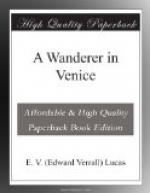This, the Giovanelli Giorgione, which in 1817 was in the Manfrini palace and was known as the “Famiglia di Giorgione,” was the picture in all Venice—indeed the picture in all the world—which most delighted Byron. “To me,” he wrote, “there are none like the Venetian—above all, Giorgione.” Beppo has some stanzas on it. Thus:—
They’ve pretty faces
yet, those same Venetians,
Black eyes, arched
brows, and sweet expressions still
Such as of old were copied
from the Grecians,
In ancient arts
by moderns mimicked ill;
And like so many Venuses of
Titian’s
(The best’s
at Florence—see it, if ye will),
They look when leaning over
the balcony,
Or stepped from out a picture
by Giorgione,
Whose tints are Truth and
Beauty at their best;
And when you to
Manfrini’s palace go,
That picture (howsoever fine
the rest)
Is loveliest to
my mind of all the show;
It may perhaps be also to
your zest
And that’s
the cause I rhyme upon it so,
’Tis but a portrait
of his Son and Wife,
And self, but such
a Woman! Love in life;
Love in full life and length,
not love ideal,
No, nor ideal
beauty, that fine name,
But something better still,
so very real,
That the sweet
Model must have been the same;
A thing that you would purchase,
beg, or steal,
Wer’t not
impossible, besides a shame;
The face recalls some face,
as ’twere with pain.
You once have seen, but ne’er
will see again;
One of those forms which flit
by us, when we
Are young, and
fix our eyes on every face:
And, oh! the Loveliness at
times we see
In momentary gliding,
the soft grace,
The Youth, the Bloom, the
Beauty which agree,
In many a nameless
being we retrace
Whose course and home we knew
not nor shall know.
Like the lost Pleiad seen
no more below.
The Giovanelli picture is one of the paintings which all the critics agree to give to Giorgione, from Sir Sidney Colvin in the Encyclopaedia Britannica to the very latest monographer, Signor Lionello Venturi, whose work, Giorgione Giorgionismo, is a monument to the diversity of expert opinion. Giorgione, short as was his life, lived at any rate for thirty years and was known near and far as a great painter, and it is to be presumed that the work that he produced is still somewhere. But Signor Lionello Venturi reduces his output to the most meagre dimensions; the conclusion being that wherever his work may be, it is anywhere but in the pictures that bear his name. The result of this critic’s heavy labours is to reduce the certain Giorgiones to thirteen, among which is the S. Rocco altar-piece. With great daring he goes on to say who painted all the others: Sebastian del Piombo this, Andrea Schiavone that, Romanino another, Titian another, and so forth.




